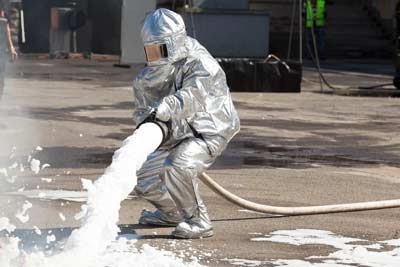Lawyers Helping Wisconsin Families Harmed by PFAS Drinking Water Contamination

PFAS substances, also known as "forever chemicals", are a collection of toxic substances that are found in groundwater and drinking water in Wisconsin and throughout the United States. Once these substances enter the environment and our bodies, they never break down. Accumulating over time, PFAS chemicals from drinking water put Wisconsin residents at an elevated risk for serious health problems including testicular cancer, kidney cancer, liver cancer and pancreatic cancer.
In Wisconsin areas where PFAS groundwater contamination has occurred, Wisconsin families have been exposed to PFAS in drinking water. The federal government has documented PFAS in the drinking water of up to 110 million Americans. A key source of PFAS in drinking water is believed to be fire-fighting foam which has been in widespread use by the military since 1969. This page contains comprehensive information on PFAS in Wisconsin drinking water including how these substances entered the groundwater in Wisconsin and what effects PFAS drinking water has on human health in Wisconsin.
PFAS Forever Chemicals in Wisconsin
PFAS, which stands for per- and poly-fluoroakyl chemicals, did not exist in groundwater or anywhere in nature before they were developed by scientists in the 1940s. Characterized by their carbon-fluorine bonds, PFAS are the most pervasive chemicals in existence, meaning they never break down. There are thousands of PFAS chemicals in existence, including PFOA (perfluorooctanoic acid), which Dupont developed to create Teflon, and PFOS (perfluorooctane sulfonate), which the federal government developed for its Scotchgard.
PFAS chemicals, which have been in heavy use for decades, are released into Wisconsin groundwater through solid-waste landfills and wastewater treatment plants, from airports and military bases, as well as from a range of industrial facilities including electroplaters, metal finishers, and petroleum refiners. Having been released at military and industrial sites in the Wisconsin area and around the country, PFAS chemicals are now found in Wisconsin groundwater and throughout our environment–in streams, lakes and oceans; in Wisconsin drinking water, both municipal and domestic; in plant matter including crops and food; and in our bodies.
PFAS from Fire-Fighting Foam in Wisconsin

Individuals can take steps to limit some of their PFAS exposure in Wisconsin, but this exposure is largely out of our hands because of PFAS contamination of drinking water in Wisconsin. Scientists are increasingly looking to military bases and airports as key PFAS groundwater polluters. A technology known as aqueous film-forming foam (AFFF) has been in widespread use by the military for putting out fires. Sprayed on fires during both training scenarios and actual emergencies, fire-fighting foam contains fluorinated PFAS chemicals. For decades, this substance has been used prolifically, with no regard to the risk of Wisconsin PFAS drinking water contamination.
Locations in Wisconsin with contaminated drinking water:
- General Mitchell International Airport, Milwaukee
- Truax Field, Madison
- Badger Army Ammunition Plant, Sauk County
- Hayward TNG Site, Hayward
- Fort McCoy, Fort McCoy
- Volk Field, Camp Douglas
Fire fighting foam was developed in the 1960s through a collaboration between the Navy and the federal government. By 1969, fire-fighting foam was required by the military in fire training, equipment testing, and emergency response. Since the 1970s, Navy and the federal government scientists have been vocal about the health risks of fire fighting foam, yet PFAS are still in widespread use. The timeline of the military's response to the threat of PFAS contaminated drinking water is one of inaction and neglect:
- 1960s: Fire fighting foam containing PFAS chemicals developed by Navy and the federal government
- 1969: Fire fighting foam adopted as standard for crash and fire training as well as emergency response
- 1970s: Navy and the federal government scientists warn of risks to human health from PFAS fire fighting foam
- 2001: Internal Department of Defense memo acknowledged that one chemical, PFOS, was "persistent, bioaccumulating and toxic."
- 2011: "Risk Alert" issued by Department of Defense
- 2015: Department of Defense begins phasing out fire fighting foams containing PFOA and PFOS, adopting a foam with different PFAS chemicals.
As of 2020, all military operations in Wisconsin and around the nation had phased out the use of fire-fighting foam containing PFOA and PFOS, which are known as "long chain" PFAS chemicals. However, the new fire-fighting foam utilizes "short-chain" PFAS substances. Short chain PFAS substances also cause cancer and scientists warn they may be more dangerous than their precursors. In comparison, PFAS-free fire fighting foam is now in wide use across Europe. At this time, the Pentagon acknowledges 401 sites where PFAS chemicals have been released into the ground. This information is incomplete, and no one knows exactly how extensive the problem actually is.
PFAS in Wisconsin Groundwater
A major issue with releasing PFAS chemicals at airports and military bases in the Wisconsin area is that these dangerous chemicals do not stay where they are dropped. PFAS substances can seep through Wisconsin groundwater and travel to remote regions through the atmosphere. PFAS "forever" chemicals have been detected in locations as far-flung as the Arctic.
Groundwater flow is a slow seepage of water along established flow paths under the surface of the earth. Water moves in predictable ways through different types of matter, varying in how far it travels based on whether the soil is loose or compact, or whether the area has underground rock, root systems, or other types of matter. PFAS chemicals released into the environment travel with groundwater wherever it goes; groundwater seepage paths range from a few feet to hundreds of miles.
PFAS in Wisconsin Drinking Water
Groundwater eventually flows to "discharge" areas where it joins other waterways such as streams, lakes, rivers and wetlands in Wisconsin. Ultimately, groundwater joins the ocean. In this way, PFAS chemicals have spread to Wisconsin water sources and around our entire world. In the United States, groundwater is the water source for half of our population, including the many homes that rely on wells. Testing of drinking water sources reveals that at least 110,000 million Americans rely on drinking water contaminated with PFAS chemicals. Wisconsin PFAS drinking water contamination has been found to increase the risk for testicular cancer, kidney cancer, liver cancer and pancreatic cancer, in addition to other health and reproductive problems.
Let Our PFAS Water Contamination Lawyers Serving Wisconsin Help You
Our attorneys specialize in holding large corporations accountable when they've placed profits ahead of safety. Through settlements and winning verdicts, our attorneys have obtained millions for our clients. Let us help you today.
PFAS Water Contamination Lawsuits for Wisconsin Residents
Filing a lawsuit will allow you to hold the federal government accountable for damage it has caused you or a loved one, while also providing real compensation for your medical expenses, suffering and loss. Contact us today for a free consultation.
